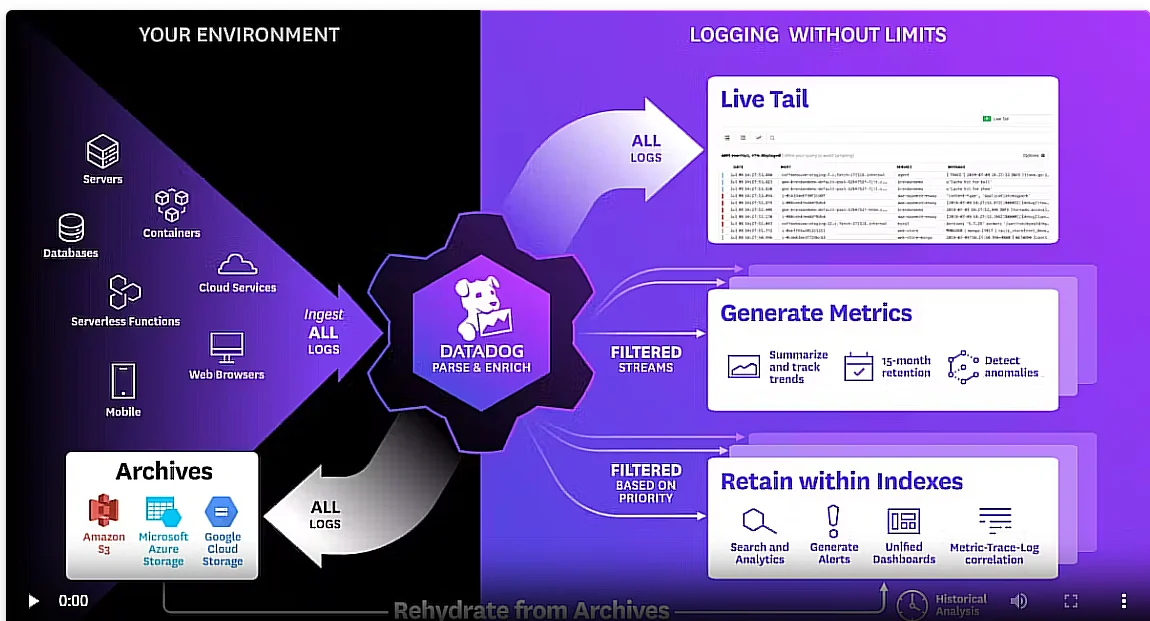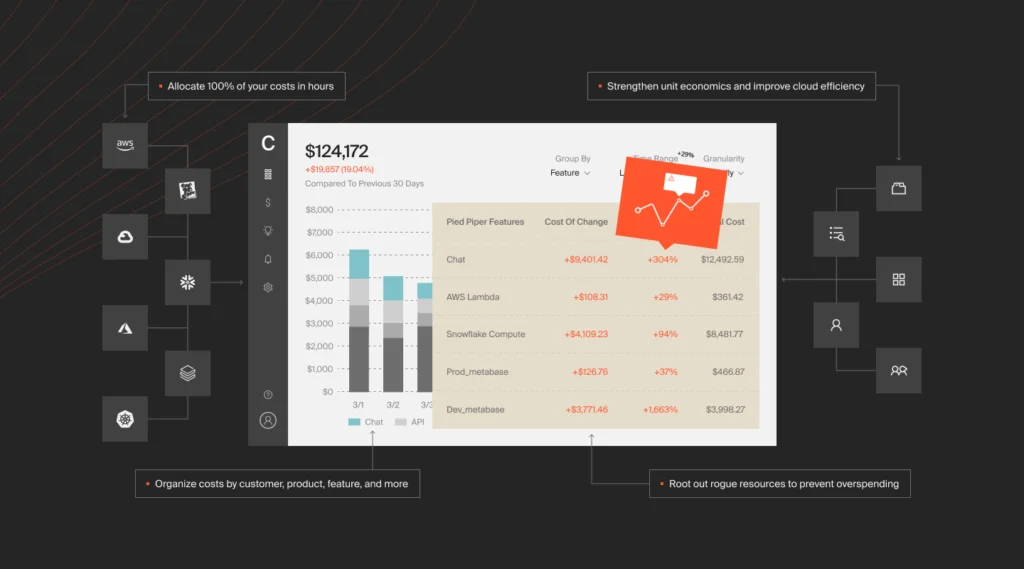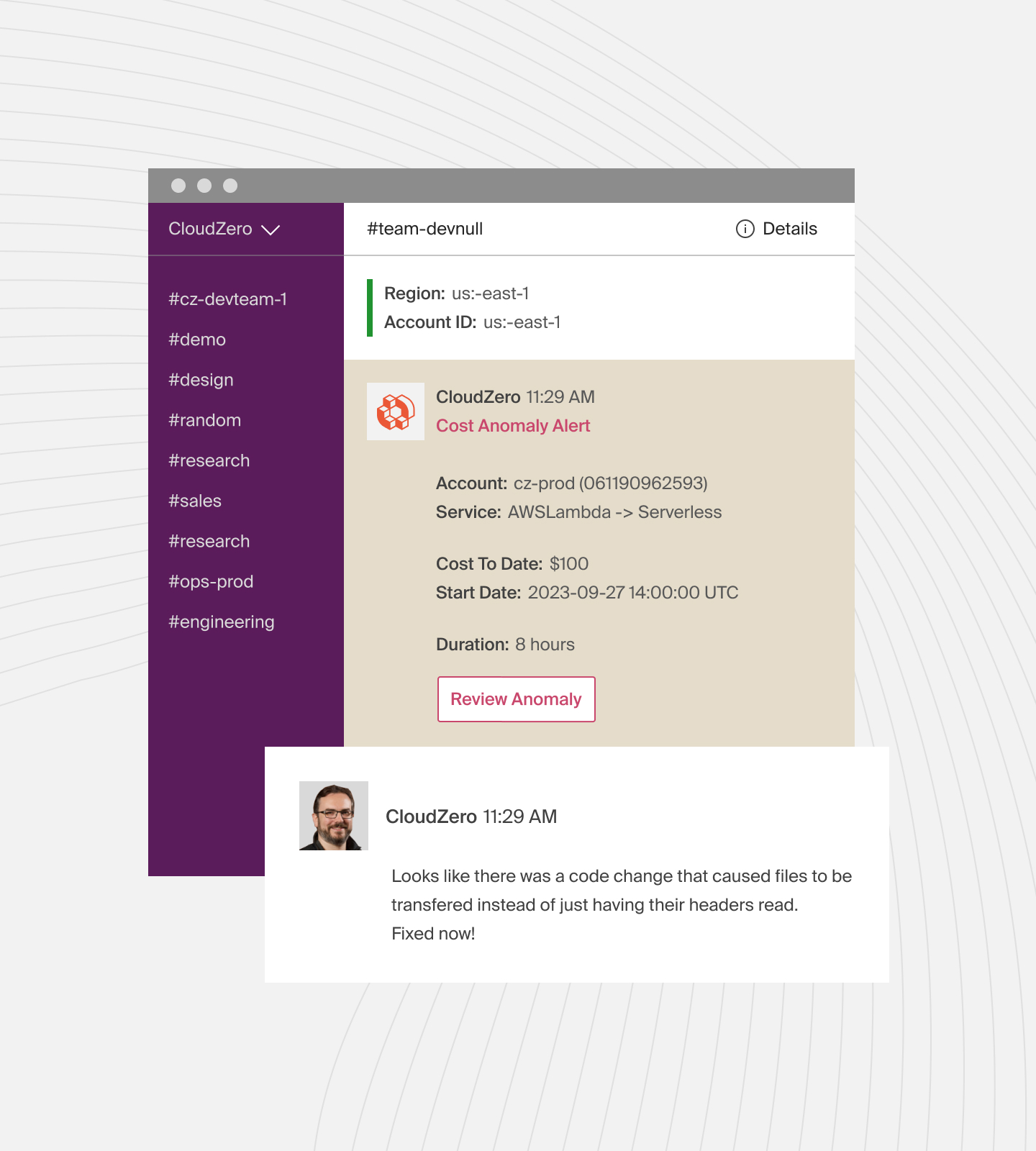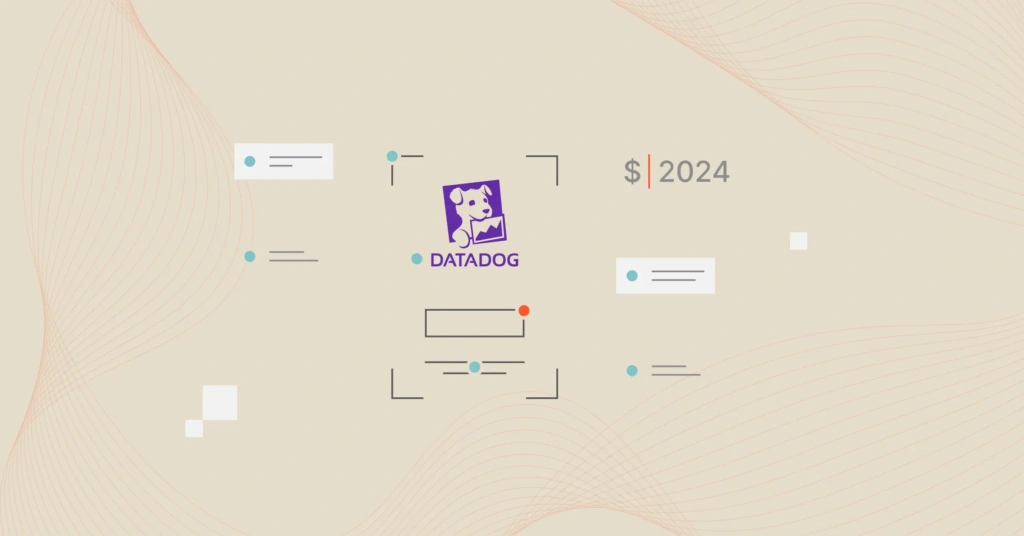In today’s fast-paced cloud environment, understanding the pricing model of some of the best cloud monitoring tools like Datadog is essential in optimizing costs. With several features and adaptable pricing, clarifying Datadog costs and aligning them with your organization’s operational needs is vital for fully harnessing this robust monitoring tool.
This guide simplifies Datadog pricing, offering a clear overview of its cost structure. Whether you’re evaluating Datadog for the first time or seeking to refine your current setup, mastering cost management is necessary.
We’ll also delve into how you can reduce and optimize your Datadog costs with a cloud cost intelligence platform.
What Is Datadog?

Datadog is a cloud monitoring and analytics tool that helps organizations ensure their applications run smoothly, regardless of their hosting environment — on-premises, hybrid, or across multiple cloud providers.
With its comprehensive toolkit, Datadog provides real-time performance tracking, alerting, and analytics, allowing teams to quickly identify and resolve issues.
Its extensive integration capabilities make it ideal for overseeing complex infrastructures, ensuring optimal application performance and improved cost efficiency.
For tips on reducing Datadog costs, check out Datadog Cost Optimization.
Datadog Pricing Model Explained
Datadog offers a flexible, tiered pricing structure designed to accommodate both small startups and large enterprises. Understanding the details of this model is key to optimizing your costs on monitoring and analytics.
Here’s a breakdown of Datadog pricing:
|
Service |
Pricing Start Point |
Details |
|
Log Monitoring |
Based on volume |
Charges per GB of uncompressed data ingested. Offers log enrichment, structuring, and dynamic routing. |
|
Application Performance Monitoring (APM) |
$31 per host/month |
Includes distributed tracing and real-time analytics. Enhanced features available in Pro and Enterprise tiers. |
|
Custom Metrics |
Based on usage |
Costs calculated based on distinct custom metrics per hour over a month. |
|
Real User Monitoring (RUM |
$1.50 per 1,000 sessions/month |
Tracks user interactions, aiding in performance improvement and user experience. |
|
Infrastructure Monitoring |
Free plan available; Pro starts at $15 per host/month |
Monitors servers, containers, and more. Pro and Enterprise plans offer extensive monitoring. |
|
Synthetic Monitoring |
API tests: $5 per 10,000 test runs/month |
Simulates user interactions to monitor web applications and APIs. Browser tests also available. |
|
Database Monitoring |
$70 per database host/month |
Provides database performance insights to optimize queries and ensure efficient data storage operations. |
Note: This chart is a simplified representation. Datadog offers custom pricing for large or complex environments, and discounts may apply for volume usage or long-term commitments.
Budgeting for Datadog
Datadog provides pricing calculators and estimation tools that can help you forecast your monthly expenses effectively. By entering your specific usage patterns, such as the number of hosts, volume of logs, and anticipated session counts, you can receive a customized estimate that aids in precise budgeting.
Here are the key considerations when planning your Datadog budget:
Scalability: Your company’s growth may necessitate monitoring additional instances, potentially leading to higher costs. Datadog’s scalable model means you only pay for what you use, providing the flexibility to adjust services as needed without financial risk.
Optimization: Datadog’s pricing calculators offer insights into potential cost optimization areas. For instance, if you discover certain logs are not essential, you might decide to reduce the volume of log data ingested. Similarly, you could adjust your APM and RUM services to better match actual usage patterns and requirements, thus optimizing your expenditure.
Forecasting Future Costs: It’s imperative to regularly review and modify your Datadog budget to align with actual usage and anticipated expansion. This ongoing adjustment process helps ensure that your monitoring costs remain consistent with your operational budget, preventing unexpected costs.
Manage, Control, And Optimize Datadog Costs With CloudZero
Managing, controlling, and optimizing cloud monitoring costs is crucial for organizations aiming to maximize their cloud spend efficiently. Datadog, with its suite of monitoring tools, offers valuable analyses into your infrastructure and applications but can also lead to unexpected costs if not managed carefully.
This is where CloudZero comes into play, offering a seamless solution to understand and manage not just Datadog costs but your entire cloud spend.
CloudZero is a cloud cost intelligence platform that offers real-time alerts into cloud spending across different services and providers, including Datadog.
By integrating CloudZero with Datadog, engineering teams can gain an instant view of their operational costs, pinpoint inefficiencies, and make informed decisions to optimize spending.
Here’s how CloudZero can enhance your Datadog cost management strategy:
1. Unified cost visibility
CloudZero aggregates cost data from various sources, including Datadog and other cloud services, into a single, intuitive dashboard. This unified view allows teams to understand their overall cloud spend and how Datadog contributes to it, making it easier to allocate budgets and track expenses against business outcomes.

2. Detailed cost analysis
With CloudZero, you can drill down into your Datadog expenses to see exactly what’s driving costs. Whether it’s specific logs, metrics, traces, or APM usage, CloudZero provides granular insights that help identify high-cost areas and opportunities for optimization.
3. Anomaly detection and alerts
Unexpected spikes in Datadog usage can lead to significant cost overruns. CloudZero’s anomaly detection and alerting capabilities notify you about unusual spending patterns in real time, enabling you to address issues before they impact your budget.

4. Cost optimization recommendations
Beyond monitoring, CloudZero analyzes your spending trends to offer actionable recommendations for reducing costs. This could involve adjusting your Datadog subscription plan, pruning unused metrics or logs, or implementing more efficient monitoring practices.
5. Collaborative cost management
CloudZero facilitates collaboration across teams by sharing cost breakdown and optimization strategies. This collective approach ensures that everyone is aligned on cost management goals and contributes to more efficient cloud usage company-wide.
 to see how CloudZero can help you understand and optimize your Datadog costs and streamline your overall cloud spend.
to see how CloudZero can help you understand and optimize your Datadog costs and streamline your overall cloud spend.
Datadog Pricing FAQ
After seeing the complexity of Datadog pricing, here are simplified FAQs for further clarity.
1. Can I try Datadog before committing to a paid plan?
Yes, Datadog offers a 14-day free trial that gives you full access to most of its monitoring and analytics features. This trial allows you to test out Datadog’s capabilities and determine how it fits with your monitoring needs before making any financial commitment.
2. How is Datadog’s pricing structured?
Datadog’s pricing is tiered, based on the level of features and the scale of your monitoring needs.
The main components affecting cost include the number of hosts or containers monitored, the volume of logs ingested, the number of custom metrics used, and the use of advanced features like APM or RUM.
Pricing varies per service, with some services offering free tiers or pay-as-you-go pricing.
3. What counts as a ‘host’ in Datadog’s pricing?
In Datadog’s context, a host is typically a physical or virtual operating system instance that you are monitoring. Depending on the service and how Datadog is implemented in your environment, this can include servers, virtual machines, or containers.
4. Does Datadog charge for data retention?
Yes, for certain services like log management, Datadog charges based on the volume of data ingested and the duration of data retention. Longer retention periods can increase costs, so it’s important to align your retention settings with your company and compliance needs.
5. How does billing work for additional features like APM or Synthetic Monitoring?
Additional features such as APM and Synthetic Monitoring are billed separately based on their specific usage metrics, like the number of hosts for APM or the number of test runs for Synthetic Monitoring.
These services can be added to your existing Datadog plan, allowing you to customize your monitoring suite to meet your needs.
6. How do CloudZero and Datadog integrate for cost management?
CloudZero integrates with Datadog by connecting to your Datadog account to display cost data within CloudZero’s platform. This allows you to monitor Datadog expenses alongside other cloud costs, enabling comprehensive cost management and optimization.
The connection is secure, with CloudZero only having read-only access to your Datadog cost data. By analyzing this data, CloudZero provides anomaly alerts and real-time insights to help you understand and control your Datadog spending efficiently.








